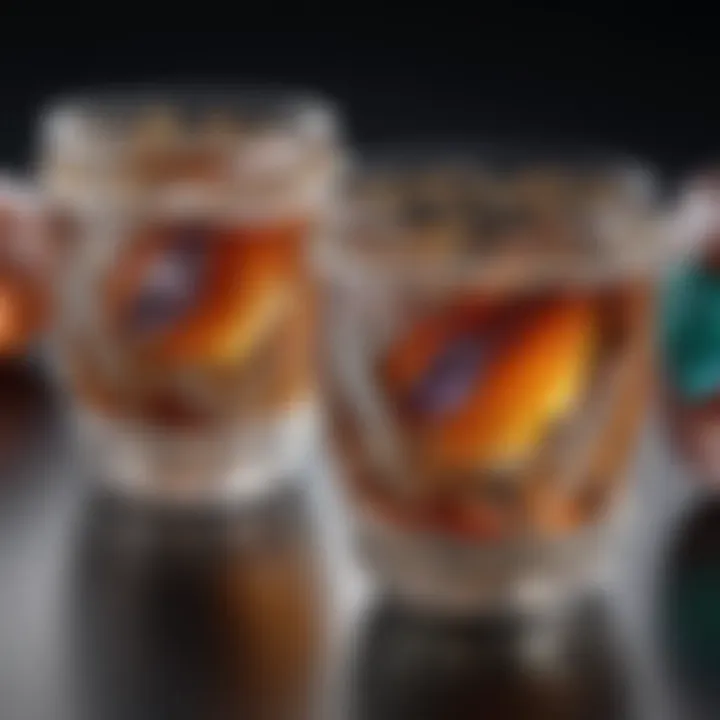Understanding Lapidary Tumblers: Design and Applications


Intro
Lapidary tumblers have become indispensable tools for gemstone enthusiasts and collectors. These devices facilitate the art of polishing stones, transforming them from rough, unremarkable pieces into polished gems that exhibit brilliant luster. The process of tumbling stones is not merely a means of beautification; it is also anchored deeply in craftsmanship and technique that raises the quality and value of gemstones. Understanding the mechanics of lapidary tumblers is vital for anyone interested in working with these stones, whether for personal enjoyment or professional endeavors.
In the following sections, we will explore various facets of lapidary tumblers, including their design, functionality, maintenance, and the materials involved in the tumbling process. We aim to cater to both newcomers to the craft and seasoned professionals, providing insights that can elevate their techniques and enhance their knowledge. The discussion will also touch upon emerging trends in lapidary technology and what these may mean for the future of the industry.
Gemstone Overview
Definition and Characteristics
Gemstones, often termed precious or semi-precious, are naturally occurring minerals or rocks that have been cut and polished for ornamental use. Each gemstone possesses unique characteristics that define its appeal and value. These qualities include:
- Color: The internal structure and impurities can affect a gemstone's color, making some more desirable than others.
- Clarity: This refers to the presence of inclusions or blemishes within the stone. A higher clarity often correlates with greater value.
- Cut: The style and execution of the cut can greatly influence a gemstone’s brilliance and overall aesthetic.
- Carat Weight: This measures the size of the gem, impacting both its value and placement in jewelry.
Understanding these characteristics is crucial for efficiently using lapidary tumblers. They can polish stones while maintaining their inherent properties, thereby enhancing their natural beauty without compromising their structure.
Classification of Gemstones
Gemstones can be classified based on their mineral composition and their perceived rarity. Common classifications include:
- Precious Gemstones: These are high-value stones such as diamonds, rubies, sapphires, and emeralds.
- Semi-Precious Gemstones: This category includes stones like amethyst, garnet, and aquamarine. While they may not carry the same price tag as precious stones, many are highly sought after for their beauty and significance.
- Organic Gemstones: These originate from living organisms, with examples including pearls, amber, and coral.
Recognizing these classifications aids enthusiasts in understanding market value and application. Different types of gemstones will require tailored approaches when being processed in tumblers, underscoring the importance of knowledgeable usage.
"The choice of gemstone significantly influences the tumbling method employed, affecting the final outcome."
The decisions made during the tumbling process—such as the selection of materials, grit size, and operational methods—depend largely on the type of gemstone being worked with. This specificity represents the artistry involved in the lapidary profession, making it both an engaging and complex field.
Prelude to Lapidary Tumblers
Lapidary tumblers are essential tools for anyone interested in the art of gemstone polishing. They play a critical role in transforming rough stones into polished gems, which are valued for both their aesthetic appeal and their potential in jewelry making. Understanding lapidary tumblers not only enlightens the enthusiasts about their function but also highlights the intricacies of the tumbling process. This knowledge is particularly important for collectors, jewelry designers, and geology enthusiasts who often strive for the highest quality finishes on their stones.
The purpose of this section is to provide a foundational understanding of what lapidary tumblers are and why they are important. By diving into their definition and purpose, readers will gain insight into the key features that distinguish various types of tumblers and their applications in the lapidary field. Additionally, this exploration serves to bridge past practices with modern advancements, demonstrating how lapidary tumblers have evolved to meet the needs of today's users.
Definition and Purpose
A lapidary tumbler is a device used to polish and smooth rough stones through a controlled rotating process. This device consists of a barrel where the stones and varying abrasives are placed. The primary purpose of a lapidary tumbler is to achieve a high-quality polish on stones that may initially look unappealing. This process is essential for enhancing the natural beauty of gemstones, making it crucial for anyone involved in gemstone-related activities.
Lapidary tumblers can be used for a range of materials including agate, jasper, and quartz. Different tumblers cater to various needs, from hobbyists working on small projects to professionals handling large batches of gems. The effectiveness of these tumblers greatly depends on factors such as the choice of medium, timing, and proper operation, making understanding their mechanics vital for success.
Historical Overview
The use of tumbling in lapidary work has a rich history that dates back centuries. It is believed that the concept originated from the need to improve the appearance of stones used in jewelry. Early techniques involved manual polishing with abrasives, which required significant labor and skill. The development of mechanical tumblers revolutionized this process, allowing for much greater efficiency.
In the early 20th century, with the advent of electric power, tumblers became increasingly sophisticated. Innovations in design and technology enabled hobbyists and professionals to achieve consistent results with less effort. The introduction of different barrel materials and sizes expanded the applications of tumblers.
As gemology and lapidary arts have gained popularity, so has the demand for tumblers. Advances in materials science have allowed for the development of more durable barrels and effective abrasives, ensuring that lapidary tumblers continue to evolve. Today, these machines are not just tools, but vital components that significantly contribute to the quality of lapidary work done across the globe.
Types of Lapidary Tumblers
Understanding the different types of lapidary tumblers is essential for gemstone enthusiasts. Each tumbler possesses unique characteristics that make them suited for various applications. This knowledge allows users to select the right equipment based on the desired outcome, whether for personal projects or professional use.
Rotary Tumblers
Rotary tumblers are perhaps the most widely recognized tumblers in lapidary work. These machines function through a continuous rotation, which moves both the rocks and the tumbling media within a cylindrical barrel. The operation can often take several days or even weeks to achieve optimal results, depending on the hardness of the material being polished.
A key benefit of rotary tumblers is their ability to produce a high shine on a variety of stones. They are generally user-friendly and suitable for beginners, making them a popular choice among hobbyists. However, the length of the tumbling process and the potential for uneven wear on stones are important considerations. Some stones can lose their shape or become scratched if not monitored closely during the process.
Vibratory Tumblers
Vibratory tumblers, in contrast, utilize a different operation mode. Instead of continuous rotation, these tumblers produce a vibrating motion that mimics the natural geological processes. This vibration allows for quick polishing, often completing the process in a matter of hours rather than days. The faster results can be a significant advantage for users looking for efficiency.


Vibratory tumblers also allow for the use of different types of media, which can lead to varied finishes on stones. This can be particularly beneficial when working with softer materials. However, they may not achieve the same level of polish as a rotary tumbler on harder stones. It is crucial to consider the stones’ specific characteristics when choosing a tumbler type.
Comparative Analysis
When comparing rotary and vibratory tumblers, several factors merit attention:
- Speed of Operation: Vibatory tumblers offer faster results, while rotary tumblers take longer.
- Finish Quality: Rotary tumblers generally produce a higher polish, suitable for harder stones. Vibratory tumblers might not provide the same gloss but excel with softer materials.
- User Experience: Rotary tumblers are ideal for beginners due to their straightforward operation. Vibratory tumblers may require more careful monitoring.
- Material Versatility: Both can work with a variety of materials, but users should choose based on their specific stone types and desired outcomes.
In choosing between rotary and vibratory tumblers, it is crucial to consider the specific needs and goals of the lapidary work. Each type of tumbler has distinct advantages and limitations, thus influencing the overall outcome of the tumbling process.
"Selecting the appropriate lapidary tumbler can significantly affect the results in gemstone polishing and finishing."
By understanding these various types, enthusiasts can make informed decisions and achieve the best results in their lapidary pursuits.
Components of a Lapidary Tumbler
Understanding the components of a lapidary tumbler is crucial for both effective operation and maintenance. Each element plays a significant role in determining the efficiency, durability, and outcome of the tumbling process. A thorough grasp of these components helps gemstone enthusiasts to optimize their results and prolong the lifespan of their tumblers.
Drive Mechanism
The drive mechanism is the heart of a lapidary tumbler. It is responsible for powering the rotation or vibration necessary for the tumbling action. There are typically two main types of drive mechanisms used in tumblers: direct-drive and belt-driven systems.
Direct-drive systems connect the motor directly to the tumbler barrel. This setup allows for efficient energy transfer, leading to consistent rotation. On the other hand, belt-driven systems use a motor to turn a belt that rotates the barrel. While these systems can offer more flexibility in speed control, they may also require more maintenance due to potential wear on the belts.
"A well-functioning drive mechanism is key to achieving the desired polish and finish on gemstones."
Barrel Types and Materials
The barrel is where the tumbling action takes place, and it is essential to select the right type based on your specific needs. Barrels come in various materials, including plastic, rubber, and metal. Each material has distinct benefits and drawbacks.
- Plastic Barrels: Lightweight and resist corrosion, plastic barrels typically enable ease of use for hobbyists.
- Rubber Barrels: These provide good cushioning for softer materials, reducing the risk of damage during the tumbling process.
- Metal Barrels: Known for their durability, metal barrels are ideal for heavy-duty operations but may require additional care to prevent rusting.
Choosing the appropriate barrel type can influence the quality of the polished finish and the compatibility with different tumbling mediums.
Lid and Seal Importance
The lid and seal of a lapidary tumbler serve critical functions. They keep the contents contained within the barrel during operation and help to maintain the optimal environment for tumbling.
A proper lid should fit securely to prevent any tumbling mediums or gemstones from spilling out during operation. The sealing mechanisms often use rubber grommets or similar materials to ensure a tight fit. This is essential not only for safety but also to minimize any loss of tumbling media or suspended materials that could affect the tumbling process.
Additionally, a well-sealed tumbler minimizes the escape of noise, which is both a comfort factor and an indication of efficient operation.
The Tumbling Process
The tumbling process is pivotal in the art of lapidary work. This step serves to smooth and polish rough stones, transforming them into exquisite gemstones ready for use in jewelry or display. Understanding the various facets of this process can significantly enhance the results achieved through tumbling. Each stage requires careful consideration of several factors, such as material selection, the type of tumbling mediums used, and timing, along with rotation speed. All these elements contribute to optimizing the overall efficiency and effectiveness of gemstone polishing.
Material Selection
When beginning the tumbling process, the choice of materials is critical. Different stones have varying degrees of hardness and characteristics that affect the final outcome. Harder materials, such as diamonds, require more aggressive tumbling methods. In contrast, softer stones like calcite demand gentler handling to avoid chipping or damaging during the process.
It is crucial to categorize stones based on their hardness according to the Mohs scale before starting. This categorization helps in selecting suitable tumbling mediums and determining the appropriate timing for the tumbling stages. Choosing incorrect materials could lead to unsatisfactory results, impacting not only the stones themselves but also the effectiveness of the tumbler used.
Tumbling Mediums
Grain Size
Grain size plays an essential role in the tumbling process. It defines the coarseness of the abrasives utilized. A fine grain size enables gradual polishing, allowing for a more refined finish on the gemstones. Conversely, larger grain sizes provide a more aggressive abrasion, useful in the initial stages of tumbling where shaping is necessary. Therefore, choosing the right grain size is crucial as it directly affects the time and efficiency needed to achieve desired results.
The unique feature of grain size is its ability to adapt to the specific needs of different stones. For example, fine abrasives are often more effective for delicate stones, ensuring a polished but not overly aggressive finish. The proper grain size is thus a popular choice among lapidary professionals because it maximizes polishing efficiency while minimizing damage.
Abrasive Types


Abrasive types involve the material compositions used in the tumbling process. These can range from natural minerals, like silicon carbide, to synthetic options, offering various benefits. For example, silicon carbide is favored for its durability and cutting ability, making it well-suited for harder stones.
Each abrasive type has its own distinct characteristics that affect both performance and the final appearance of gemstones. The unique feature of polymer-based abrasives is their ability to provide a controlled polish, suitable for softer materials. However, professionals must choose carefully, as some abrasives can leave residue, impacting the cleanliness of the final product.
Plastic Abrasive Options
Plastic abrasive options represent an innovative advancement in tumbling media. These options are lighter and less aggressive than traditional abrasives. Their key characteristic is their ability to prevent excessive wear on softer stones, allowing for safe and efficient polishing.
These options often provide a smoother finish while reducing the risk of implementing scratches or chips during the process. However, some lapidary experts argue that they may not be as effective for achieving a high shine compared to harder abrasives. Nonetheless, plastic abrasives are gaining popularity due to their versatility and safety for various types of gemstones.
Timing and Rotation Speed
Timing and rotation speed in the tumbling process have a direct impact on the outcome. These factors determine how long the stones remain in the tumbler and how aggressively they are polished. A consistent rotation speed allows for even tumbling, which leads to uniform results across all stones in the barrel. Additionally, timing must be closely monitored; over- or under-tumbling can lead to inadequate polishing or even damage to the gemstones. Through proper management of these elements, lapidarians can optimize their tumbling process and achieve better quality in their finished products.
Best Practices for Using Lapidary Tumblers
Using lapidary tumblers effectively involves understanding proper setup, monitoring, and maintenance practices. Each step in the tumbling process impacts the final outcome, which can significantly enhance the aesthetic and structural quality of gemstones. Not applying the best practices can lead to subpar results and even damage to the stones or machinery. By adhering to these guidelines, both beginners and experienced hobbyists can achieve the desired finish on their gems and ensure the longevity of their tumblers.
Initial Setup
The initial setup of a lapidary tumbler is crucial to the success of the tumbling process. It involves not just placing the stones inside the tumbler but also ensuring that all components are in proper working order.
- Selection of Materials: Choose the right stones based on the hardness and tumbling time needed. Softer stones may require less abrasive mediums, while harder stones need more intense abrasion.
- Balancing the Load: Ensure that the barrel is not overloaded. An overload can cause uneven tumbling and reduce effectiveness. Generally, the barrel should be filled to about two-thirds full for optimal performance.
- Adding the Tumbling Medium: Select the correct type and amount of tumbling medium, which can be grit, ceramic media, or plastic pellets. The choice depends on the type of stones being used. Begin with a coarse grit for initial shaping, transitioning through finer grits as the stones smooth out.
- Sealing the Barrel: Ensure the lid is sealed properly. A loose lid can cause grit and stones to leak out, contributing to waste and a messy workspace.
Taking these steps during the initial setup will promote an efficient tumbling process and improve the ultimate results.
Monitoring the Process
During the tumbling process, continuous monitoring is necessary to guarantee the effectiveness of the tumbling and to adjust parameters as needed. Regular checks can help address any issues before they affect the outcome.
- Tumbling Time: Pay attention to the time intervals suggested for different types of grit. Starting with a 7 to 10-day period is typical for coarse grit, adjusting as necessary.
- Noise Levels: Listen for any unusual sounds. A grinding or scraping noise can indicate an issue with loading or that the tumbler is working too hard.
- Visual Inspection: Periodically check the stones through the lid if your tumbler design allows it. Inspecting will confirm if the stones are progressing as anticipated.
- Check Seal and Grit Levels: Occasionally, you should verify if the barrel is sealed and if there is sufficient grit inside the tumbler.
Regular monitoring helps avoid failures, ensuring an even finish on the stones.
Post-Tumbling Cleanup
After the tumbling process is complete, effective cleanup is essential for both the tumbler and the finished stones. Neglecting this step can lead to grit build-up and decreased performance in future uses.
- Removing the Stones: Carefully extract the stones and rinse them thoroughly under running water to remove all grit and debris. Failure to do this can leave residues that hinder their finish.
- Cleaning the Barrel: After removing the stones, it is good practice to clean the tumbler barrel. Use warm soapy water to eliminate any grit and ensure it is completely dry before reusing.
- Inspecting for Damage: This is an opportune time to inspect the stones for any potential damage. If stones appear chipped or cracked, it is best to remove them from future batches.
- Store Properly: Store finished stones gently, avoiding any potential scratches or damage. Equally, keep tumbling materials organized and separate from finished products to maintain clarity in the process.
Maintenance of Lapidary Tumblers
Proper maintenance of lapidary tumblers is crucial for ensuring their performance and longevity. Regular maintenance helps avoid common pitfalls that can lead to inefficient tumbling or even damage to the equipment. By keeping tumblers in excellent condition, users can optimize the polishing process for gemstones and other materials.
Regular Checks and Cleaning
Regular checks and cleaning are essential practices that significantly affect the functionality of lapidary tumblers. Ensuring proper cleaning prevents residual materials from contaminating new batches of stones, which can adversely affect the polishing quality.
Key Steps for Regular Checks and Cleaning:
- Inspect the Barrel: Regularly examine the barrel for signs of wear or cracks. Over time, even a minor crack can lead to leaks or contamination.
- Check the Seals: The seals should be intact to ensure that no water or grit escapes during the tumbling process.
- Clean the Components: Use soap and water to clean all parts of the tumbler. Mild abrasive cleaners can be used, but always ensure that all residues are removed afterward.
Keeping the tumbler clean also plays an vital role in maintaining the precise balance during operation, which can help in achieving a consistent finish.
Troubleshooting Common Issues
Despite proper maintenance, tumbler users may encounter various issues. Troubleshooting these problems involves recognizing symptoms and responding appropriately to restore functionality.
Common issues include:
- Excessive Noise: If the tumbler operates noisily, there may be worn bearings or imbalances within the barrel. Addressing this quickly is necessary, as it can indicate underlying mechanical failure.
- Vibrations: Excessive vibrations can signal that the barrel is not properly loaded, or that the drive mechanism requires adjustment. Balancing the load is critical to reducing excess vibration.
- Slow Rotation: A decline in speed might indicate an issue with the motor or drive belt. It’s important to check these components and replace them if necessary.


"Regular maintenance helps prevent many of the common issues faced during lapidary processes."
By incorporating routine checks and resolving issues promptly, users can ensure that their lapidary tumblers perform efficiently, leading to better outcomes in gemstone polishing.
Safety Considerations
Safety is a critical aspect when working with lapidary tumblers. Engaging in the tumbling process involves various materials, equipment, and potential hazards. Understanding these safety considerations can minimize risks and enhance the overall experience.
The main focus of safety in lapidary tumbling includes the use of protective gear and ensuring adequate ventilation in the workspace.
Protective Gear
Wearing appropriate protective gear is essential to safeguard oneself against potential injuries during the tumbling process. Here are the primary items recommended for gemstone enthusiasts:
- Safety Goggles: Protect the eyes from dust particles and flying debris. Small fragments may become airborne during the tumbling process.
- Dust Masks: When handling materials such as polishing compounds or fine particulates, wearing a dust mask can help in avoiding respiratory issues. It's vital to select masks rated for scrubing fine particles effectively.
- Ear Protection: Tumblers, especially rotary models, can generate significant noise. Using earplugs or earmuffs can prevent hearing damage during prolonged usage.
- Gloves: Disposable or reusable gloves protect the skin when handling potentially abrasive materials or chemicals used in the tumbling process.
Using the right protective gear not only reduces risks of injuries but also fosters a more comfortable working environment.
Ventilation Needs
A well-ventilated workspace is necessary for safe gemstone polishing and tumbling. Ventilation plays a crucial role by:
- Reducing Exposure to Harmful Dust: Many tumbling mediums can create fine dust that is hazardous when inhaled. Adequate airflow helps to dissipate dust, reducing exposure.
- Minimizing Fumes: If chemical compounds are used during polishing, they may emit fumes. Good ventilation ensures that these fumes do not accumulate in the workspace.
- Maintaining Comfortable Temperatures: Tumbling machines can generate heat, which can lead to uncomfortable working conditions. Proper ventilation helps circulate air thus keeping the environment cooler.
Plan the workspace layout to allow for windows, fans, or exhaust systems that promote airflow. This practice will create a safer and more pleasant environment for lapidary activities.
Key Reminder: Prioritizing safety in lapidary tumbling not only protects the individual but ensures a more efficient and enjoyable gemstone finishing process.
Market Trends and Innovations
The market for lapidary tumblers is rapidly evolving. Understanding current trends and innovations is essential for both amateur and professional gem enthusiasts. The advances in technology directly affect the efficiency, safety, and outcomes of the tumbling process. This section explores key elements that shape the future of lapidary tumblers.
Emerging Technologies
Recent advancements in lapidary tumbler design have brought better performance and user-friendliness. For instance, some tumblers now integrate smart technology that allows users to monitor the tumbling process remotely. These innovations offer greater control over the tumbling period and conditions.
Another notable development is the use of advanced materials for barrels. Modern tumblers may feature high-density polyethylene or specialized rubber that enhances durability and reduces friction. This improvement leads to faster, more effective polishing of gemstones.
Additionally, the implementation of variable speed and timing settings enables users to customize the tumbling experience. By adjusting these parameters, enthusiasts can achieve optimal results tailored to different types of stones and desired finishes.
Consumer Preferences
Consumer preferences also play a significant role in shaping market trends. Gemstone enthusiasts now lean towards versatility and ease of use when selecting lapidary tumblers. There is an increasing demand for tumblers that can handle various sizes and types of materials, offering a one-stop solution for diverse polishing needs.
Moreover, sustainability is becoming increasingly important. Customers are looking for eco-friendly tumblers that utilize less energy and reduce waste. Many manufacturers are responding by developing energy-efficient models and sourcing sustainable materials for production.
Prices and features are closely linked with consumer choices. More buyers are willing to invest in higher-end models if they come with advanced features, such as noise reduction and enhanced safety mechanisms.
"The rise of technology in lapidary tumblers mirrors a broader trend in home crafting, where convenience and performance are prioritized by consumers."
In summary, keeping abreast of market trends and innovations in lapidary tumblers is crucial for any serious gemstone enthusiast. It allows for informed purchasing decisions and ensures optimal performance in polishing and finishing gemstones.
Culmination
The conclusion of this article serves to highlight the significance of lapidary tumblers in the realm of gemstone processing and design. With their efficient operation and versatility, lapidary tumblers provide essential benefits for both amateur hobbyists and professional jewelers. They not only aid in polishing stones to a brilliant shine but also help in shaping and refining the characteristics of various gemstones.
Recap of Key Points
In this article, we explored several crucial aspects related to lapidary tumblers:
- Definition and Purpose: We defined lapidary tumblers and outlined their primary function in the gemstone finishing process.
- Types of Tumblers: We reviewed rotary and vibratory tumblers, elucidating their distinct mechanics and applications.
- Components and Setup: Detailed descriptions of important components that include drive mechanisms, barrel types, and the significance of lids and seals were discussed.
- Tumbling Process: Key factors in material selection, tumbling mediums, and the importance of timing and speed were examined.
- Best Practices: Guidelines for effective setup, monitoring, and cleanup post-tumbling were identified.
- Maintenance: Insights into routine maintenance and troubleshooting common issues were shared.
- Safety Considerations: We emphasized the importance of protective gear and adequate ventilation.
- Market Trends and Innovations: Overview of emerging technologies and consumer preferences revealed the dynamic nature of the lapidary field.
Future Directions in Lapidary Practice
As we look ahead, several potential developments in lapidary practice seem promising:
- Automation of Tumblers: Advances in technology may lead to more automated processes that enhance efficiency and user convenience.
- Sustainability Practices: There is an increasing demand for environmentally friendly tumbling media and methods that minimize waste.
- Customization: The future of lapidary tumblers could include more customizable options, allowing users to tailor setups to meet specific needs.
- Integration of Smart Technology: Features like IoT connectivity may enable users to monitor tumbling processes remotely, improving safety and user experience.
- Community Sharing: Platforms like Reddit and Facebook groups may foster enhanced knowledge sharing among lapidary enthusiasts, keeping individuals updated on trends and best practices.







